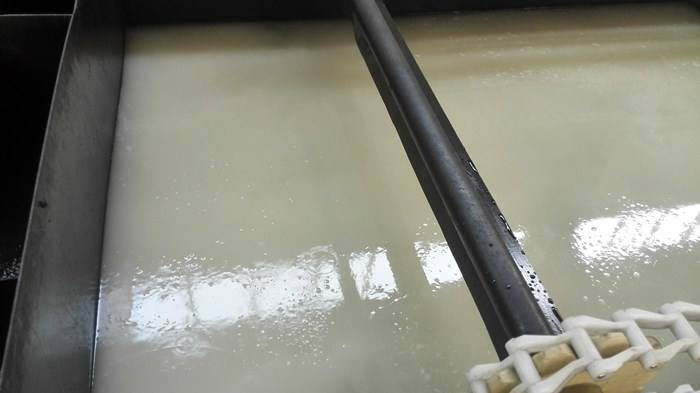

In furniture manufacturing, spray paint wastewater is a challenging effluent containing high organic loads and solids. This case study examines a comprehensive spray paint wastewater treatment solution for a furniture factory, highlighting the role of coagulant and flocculant chemicals. We detail the typical contaminants, the treatment flow (coagulation+flocculation+sedimentation+filtration), and the benefits of TAIRAN CHEMICAL’s products in achieving clear effluent and compliance.
Spray paint wastewater from furniture finishing is highly polluted and viscous. It typically contains:
High COD: Organic solvents like toluene, xylene, acetone, and ethyl acetate raise the chemical oxygen demand.
Oil & Grease: Oil-based paint components and resins form emulsions and oils that coat particles.
Suspended Solids: Wood dust, overspray paint particles, and metal flakes create fine solids.
Other pollutants: Potentially heavy metals and VOCs that must be removed to meet discharge limits.
These pollutants make the wastewater sticky and difficult to treat. Achieving clear effluent is crucial to meet environmental discharge limits. The U.S. EPA, for example, enforces strict industrial effluent guidelines to ensure wastewater discharges meet water quality standards.
The typical treatment flow is: coagulation → flocculation → sedimentation → filtration. In practice this involves:
Coagulation: Dose TAIRAN’s Polyaluminium Chloride (PAC) to neutralize charges and break oil emulsions. PAC rapidly aggregates fine particles into micro-flocs.
Flocculation: Add a polymer flocculant. Typically anionic PAM is used: TAIRAN’s Anionic Polyacrylamide (APAM) is added to bridge micro-flocs into larger flocs. APAM acts as a flocculant polymer for paint wastewater, linking paint particles so they settle more quickly. (In some cases, cationic PAM may be used to target negatively charged colloids.)
Sedimentation: Allow the large flocs to settle in a clarifier or flotation unit, separating solids from the clear water.
Filtration: Pass the clarified water through sand filters or membrane filters to polish out residual solids, yielding clear effluent.
Sludge Dewatering (optional): Dewater the settled sludge. Adding Cationic Polyacrylamide (CPAM) can condense sludge and improve water loss.
TAIRAN CHEMICAL provides high-performance chemicals for each step. Polyaluminium Chloride (PAC) is a powerful inorganic coagulant. Its high positive charge quickly neutralizes paint colloids and oils, causing them to coalesce. PAC’s rapid flocculation produces a dense coagulated sludge, improving initial solids capture and water clarity. For example, PAC’s high charge density “ensures fast floc formation, improved clarity, and reduced sludge volume”.
After coagulation, TAIRAN’s polymer flocculants complete the treatment. Anionic polyacrylamide (APAM) is used to bridge and grow the flocs. APAM chains adsorb onto particles and tie them into large settleable flocs. This dramatically enhances settling. In fact, studies show that compared to coagulant alone, adding a PAM flocculant yields much stronger flocs at lower doses. TAIRAN’s APAM grades are formulated for paint-shop wastewater and work effectively across a broad pH range, reducing suspended solids and organics. If the sludge contains fine organics or needs dewatering, a cationic polyacrylamide (CPAM) can be applied. CPAM is especially good at tightening sludge and improving dewatering (reducing sludge volume).
Rapid Floc Formation: TAIRAN’s PAC creates instant micro-flocs and APAM bridges them into larger flocs. The result is swift solids removal and much clearer water.
High Clarity: The combination of PAC and PAM removes >90% of suspended solids and VOCs. The treated effluent meets discharge limits for color, turbidity and COD, enabling reuse. (Long-term re-circulation of water in spray booths reduces freshwater use.)
Lower Sludge Volume: These inorganic+organic coagulants minimize sludge. In fact, TAIRAN notes PAC use “reduces sludge volume” while improving clarity. Using CPAM for dewatering further compresses the sludge.
Cost Efficiency: PAC and PAM are effective at low dosages, cutting chemical costs. Better coagulation means less frequent filter backwash and longer system runs.
Environmental Compliance: The treated water easily meets strict industrial discharge standards (e.g. EPA effluent guidelines. By adopting this furniture factory wastewater treatment solution, manufacturers ensure regulatory compliance and sustainable operation.
Paint shop wastewater must comply with local and international discharge limits for COD, oil, metals and solids. For example, the U.S. EPA’s Effluent Guidelines set technology-based limits on industrial discharges. TAIRAN’s treatment process is designed to achieve these levels: PAC and PAM removal of >95% suspended solids and organics typically brings effluent COD below stringent limits. In some regions, treated water may even meet standards for reuse in cooling or flushing. Overall, this process ensures the factory meets environmental regulations while minimizing water consumption.
In summary, spray paint wastewater from furniture factories poses serious treatment challenges (high COD, oils, solids). An effective solution combines TAIRAN CHEMICAL’s high-charge Polyaluminium Chloride (PAC) coagulant with polymeric flocculants (Anionic PAM (APAM) and Cationic PAM (CPAM)). The flow (coagulation+flocculation+clarification+filtration) yields large flocs and crystal-clear effluent, enabling water reuse and compliance with WHO/EPA standards. In practice, implementing this spray paint wastewater treatment system at a furniture plant results in dramatic clarity improvements and sludge reduction, making it a sustainable, cost-effective wastewater treatment solution for the furniture industry.
Sources: TAIRAN CHEMICAL product literature and case studies tairanchemical.com tairanchemical.com tairanchemical.com tairanchemical.com ; U.S. EPA Effluent Guidelines on industrial wastewater epa.gov .